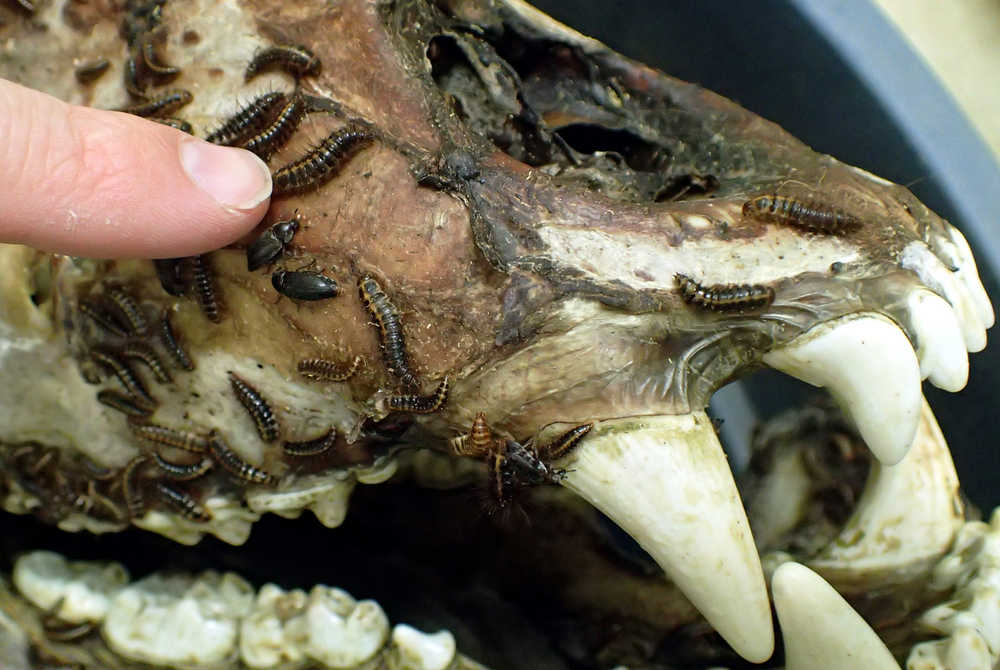Aren Gunderson parks his truck, steps out and strips off his sweatshirt.
“I always take off my outer clothing layer,” says the caretaker of the University of Alaska Museum’s colony of flesh-eating beetles. “The stink will stay with you.”
Gunderson, mammal collection manager at the museum, approaches a weathered set of buildings. He swings open a door. The dermestid beetles are housed about one mile from the museum.
A scan of the room shows varied carcasses on their way to becoming skeletons. A baby killer whale in a box. A racing husky in a plastic tote. In a 40-gallon barrel, a grizzly killed in defense of life and property. Its jaws, wrists and toe bones point to the ceiling.
The visual is stirring, but a scent like leather and candy and hot springs makes breathing difficult.
“Some student workers just can’t handle it,” Gunderson says of the odor. “Some like it. I like it.”
Using a spritzer bottle, Gunderson squirts the bones of the grizzly with water. The bear comes alive with squirming larvae and adult beetles the size of fingernails.
“There are probably millions of beetles in this room,” Gunderson says. “When you spray them, they really come out of the woodwork.”
So they do. Creepy crawlies slithering over grizzly teeth, a smooth wolf skull, the knobby links of a dog’s tail. Handsome armored adult beetles and their segmented offspring looking like centipedes.
These beetles are a tropical species that could not survive a Fairbanks winter without help. Gunderson keeps the room at 80 degrees to keep his troops happy. That heat adds to the stifling quality of the air. Even though my nose has dulled to the stink, the air is heavy and rank, encouraging the shallowest of breaths.
More than 2,000 carcasses arrive at the museum each year. Walrus, moose, minke whale, shrew — the mammals collection takes most of them. After the beetles clean them and the bones are soaked in ammonia to remove the grease, skeletons go up the hill to the museum. Researchers from around the world use the bones to learn more about the animals.
The bug colony is separate from the museum. If they got loose up there, the beetles would eat everything carbon-based, including dead plant and paper material.
“Dermestid colony personnel are under constant scrutiny from the rest of the (museum) staff because of the potential for introduction of dermestids to the collections,” reads a manual for colony caretakers. “If showering is not possible, shake out your hair, wash hands thoroughly, and change clothes and footwear before returning to the museum.”
Hunters call the museum asking for help in removing flesh from moose and bear skulls. The university’s beetles are too busy to help, Gunderson tells them, but the mammal collection staff will give a workshop next fall. If hunters fail to make that and live with a sympathetic housemate, Gunderson recommends boiling or pressure-cooking skulls.
“The meat will fall off like pulled pork,” he says.
To end the tour of the meat-removal facility, Gunderson leads me to another room. Here are five plastic garbage cans that contain four walrus. The containers are filled with water. A gag-inducing scum floats on top. The room reaches a new level of stench. It’s like bumping into a wet, sour wall. The impulse to turn and run is strong.
Underwater, anaerobic bacteria are consuming the protein in the walrus flesh in a process called maceration. The offgassing of the putrification process waters the eyes. The bacterial emissions include ammonia, hydrogen sulfide and ethanethiol, a gas so revolting we add it to propane because we can detect just a few molecules. I don’t envy the student whose job is to skim off the floating, vomit-colored skin with a pasta strainer and burn it.
While beetles can strip a butchered walrus in one month, the bacteria will take four months. These walrus have been soaking for two months.
“Maceration takes longer and is grosser,” Gunderson says.
But all those tiny organisms are working magic. Without them, the world would cease to have any room. Northern-adapted relatives of these beetles scuttle to any carcass that drops in the Alaska woods. They clean the bones after larger scavengers have gotten their fill.
The tiny members of the museum’s beetle colony, one of the largest captive groups of any museum, work away without complaint each day of the year. Their keepers make them happy with a conveyor belt of fresh carcasses and squirts of water every few days. The bugs give them clean skeletons.
“They are low maintenance,” Gunderson says. “And they work for free.”
• Ned Rozell is a science writer for the Geophysical Institute. Since the late 1970s, the University of Alaska Fairbanks’ Geophysical Institute has provided this column free in cooperation with the UAF research community.

